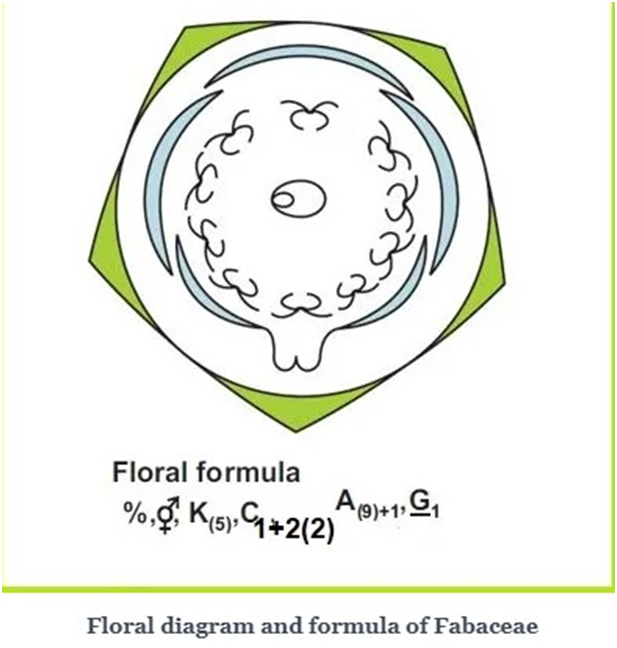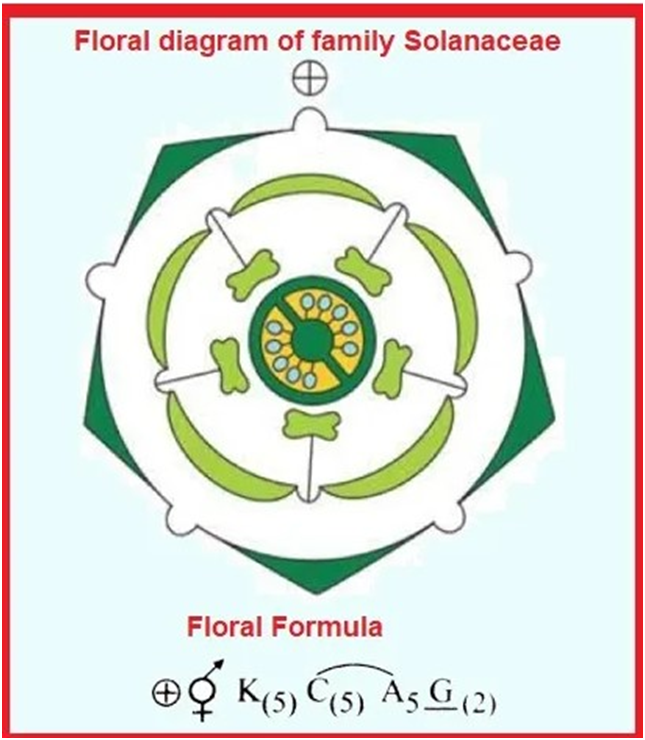Description of some important families
A. FABACEAE
It is also called Leguminosae, It consists of legumes such as the pea, or bean family, and is a large and agriculturally important family of flowering plants.
Vegetative Characters
Root: Dicotyledons, taproot with root nodules.
Stem: Erect or climber; Fabaceae includes shrubs, herbs, trees and majorly climbers.
Leaves: Petiolate, pinnately compound or simple; pulvinus leaf base, stipulate; reticulate venation.
Floral Characters
Inflorescence: Racemose.
Flower: Complete, bisexual, zygomorphic, hypogynous, bracteate/ ebracteate.
Calyx: Five sepals, gamosepalous; valvate or imbricate aestivation.
Corolla: Five petals, polypetalous, papilionaceous, vexillary aestivation.
Androecium: Ten stamens (9+1), diadelphous, anther dithecous.
Gynoecium: Superior ovary, monocarpellary, unilocular, single, short -style and flat, hairy-stigma.
Fruit: Legume.
Seed: One or more, non-endospermic.
Economic Importance
Many plants belonging to this family are economically useful. A few of them are listed below:
The plants of this family are unique and have root nodules that contain nitrogen-fixing symbiotic bacteria, capable of transforming atmospheric nitrogen into fixed nitrogen or ammonia. Pulses like gram, moong, and soya bean are the main source of food. The Mulethiplant is known for its medicinal value. Soya bean and groundnuts are used to extract oil that is used for cooking. Sunn hemp is the source

B. SOLANACEAE
It is a family of flowering plants that ranges from annual and perennial herbs to vines, epiphytes, shrubs, and trees, and includes a number of agricultural crops, medicinal plants, spices, weeds, and ornamentals.
Vegetative Characters
Root System: Taproot system.
Stem: Erect or climber; Solanaceae includes herbs, shrubs, small trees, and climbers.
Leaves: Alternate, simple or pinnately compound (rarely); exstipulate; reticulate venation.
Floral characters
Inflorescence: Racemose- terminal or axillary raceme; Cymose- solitary in Solanum.
Flower: Complete, bisexual, actinomorphic, hypogynous.
Calyx: Five sepals, gamosepalous; valvate aestivation.
Corolla: Five petals, gamopetalous, valvate aestivation.
Androecium: Five stamens, epipetalous; anthers basifixed.
Gynoecium: Syncarpous, bicarpellary, bilocular, superior ovary, axile placentation.
Fruit: Berry/ capsule.
Seed: Numerous, endospermic.
Economic Importance
These are an important source of food. E.g. tomato, brinjal and potato. These are important sources of spices. E.g. chilly. The leaves of Nicotiana tabacum are a major source of tobacco.These are also used as ornamental plants. E.g. petunia. Plants such as Belladonna and Ashwagandha are also used as medicinal plants.

C. LILIACEAE
Liliaceae is the family of around 2500 species of perennial, herbaceous monocots. It is also known as the ‘lily family’.
Vegetative Characters
Root: Fibrous root system.
Stem: Erect; Liliaceae includes perennial herbs which propagate through bulbs or rhizomes.
Leaves: Alternate, simple; exstipulate; parallel venation.
Floral characters
Inflorescence: Cymose- solitary; umbellate clusters.
Flower: Complete, bisexual, actinomorphic; hypogynous, perianth present.
Perianth: Indistinctive sepal and petal; six tepals (3+3), often united tepals; valvate aestivation.
Androecium: Six stamens in two whorls (3+3).
Gynoecium: Syncarpous, tricarpellary, trilocular, superior ovary with axile placentation.
Fruit: Mostly Capsule and sometimes berry.
Seed: Endospermic seeds.
Economic Importance
The plants belonging to the Liliaceae family are a source of Medicine -Aloe vera, Smilax and Colchicine. They are also used as ornamental plants -Lilium, tulips, Gloriosa, and Ruscus. They are also exploited as a source of food (or) Vegetables-Asparagus.Bulbs of Allium cepa and the roots of various species of Smilax are used as flavouring agents.


 ACME SMART PUBLICATION
ACME SMART PUBLICATION
